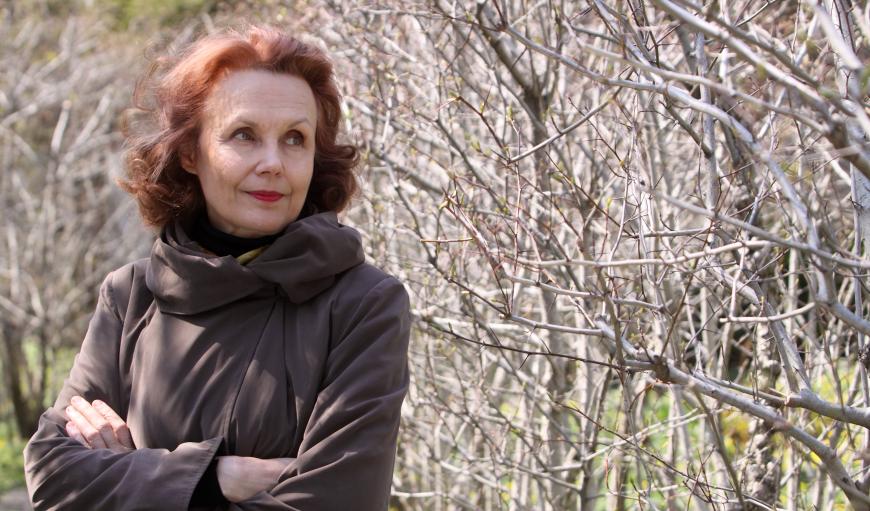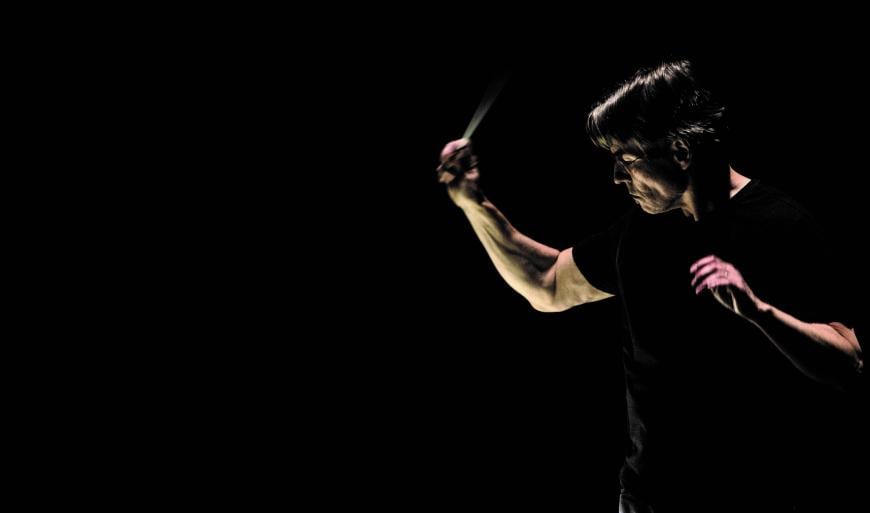
A swimming pool, Trump Tower, a trashy trailer park, a cruise ship, outer space. Director Peter Sellars has made a reputation out of placing operas in innovative environments. Now without a set, costumes, or props, he’s reimagining Kaija Saariaho’s Adriana Mater for Davies Symphony Hall. Just the San Francisco Symphony, Music Director Esa-Pekka Salonen, four singers, and a chorus, on a stage without a proscenium arch, feature in this concert production June 8–11.
“In concert, the opera has a very different sense of time,” said Sellars on a video call between rehearsals at Davies. “Now you can feel this as a memory; you can really hear words as a meditation.”
Adriana Mater is set during a civil war in an unnamed country at an unspecified time. Sung in French, the story reflects on motherhood as a result of rape in a violent world while inviting viewers to consider their own relationships with revenge and forgiveness.
This concert staging isn’t Sellars’s, or Salonen’s, first rodeo with Adriana Mater. They were part of the creative team, including librettist Amin Maalouf, behind the work’s 2006 world premiere at the Opéra Bastille in Paris. Salonen also conducted its Finnish premiere in 2008, and in the same year, Sellars completely restaged the work for its U.S. premiere at Santa Fe Opera. The San Francisco performances will be the first staged concert version of Adriana Mater.

Sellars’s work often deals with controversial contemporary subject matter — earlier collaborations with composer John Adams on the operas The Death of Klinghoffer, Nixon in China, and Doctor Atomic still spark discussion. Adriana Mater is no exception. Turning such subject matter into operas that are entertaining and musically exciting would be a challenge for many directors. But the way Sellars tells it, music is a way to make two hours become unforgettable.
“I don’t really think of entertainment as anything we’re doing,” he said. “For me, the art form invites you to go deeply into the history of a contemporary moment because what you’re looking at right now is history. It did not finish; you’re still in it.”
In the concert staging of Adriana Mater, Sellars is seeking the interplay of light, music, and emotions to color how the opera is taken in. “If you’re feeling things because the music changes, or the color you’re seeing changes the music — all of those things are a huge interplay of that. None of that is flat. All of that is alive and moving.”
But the audience won’t see singers or musicians running around the stage. “Nobody’s going anywhere. So what you’re going to get at Davies Hall is orchestral color but also light itself. And these incredible illuminations of light inside of darkness and darkness inside of light,” said Sellars, noting he’s working with James F. Ingalls, who also designed the lighting for the opera’s Paris premiere. That production featured an apocalyptic set design of translucent fiberglass mounds that vaguely suggested the war architecture of a destroyed Middle Eastern or Balkan village. The mounds were both lit from within and projected upon.
Critical reception of Adriana Mater has been mixed from the start. “The challenge was so direct, and strangely, if this piece felt abrasive to some people when it was new, now it has an amazing quality of consolation,” said the 65-year-old Sellars, who teaches at UCLA.
Sensibilities, however, have changed since the opera was first conceived, he said. “It’s a different world today. The image that we made 20 years ago of a young man entering a public place with an AK-15 in his hands — we now all react to that differently.”
Sellars believes the passage of time has allowed the piece to now speak in a way it couldn’t when it was first performed. “Its beauty was harder to hear when it was new. And the poetry of it was harder to experience.”

The two-act work, Saariaho’s second opera, has rarely been performed for reasons unknown to Sellars. But he still has a strong connection to it. “Kaija’s music is right in the heart of that which is very eloquent and very moving.” After the opera’s premiere, Saariaho credited Sellars with adding a dimension of hope to the work that she hadn’t envisioned. And in an unusual gesture for a composer to a stage director, she dedicated the opera to him (and to the memory of her mother).
The Paris-based Saariaho, a major force in contemporary music for decades, initially worked with Sellars on her first opera, L’Amour de loin (Love from afar). She’s known the 64-year-old Salonen since both were students at Helsinki’s Sibelius Academy. (Her daughter Aliisa is Salonen’s assistant; her son Aleksi assisted Sellars in the 2008 Santa Fe production of Adriana Mater, and he translated the libretto for his mother’s newest opera, Innocence.)
The now 70-year-old Saariaho has said memories of her first pregnancy partly inspired Adriana Mater. “When I understood in my heart, in my body, that there were two hearts beating at the same time, that was, for me, an idea that really struck,” she told an interviewer in 2008. Maalouf told reporters he used his memories as a war correspondent and his awareness of contemporary political and religious conflicts as themes in the opera.
Saariaho dislikes being identified by her gender in professional contexts, said Sellars. “All her life she has been annoyed with people that celebrate her as a female composer. She’s said, ‘I’m just a composer. That’s enough.’ At the same time, when it was time to write her second opera, she wanted to write about motherhood.”
It’s a new cast in this concert production, and Sellars anticipates a very different set of responses to the music and the story, not only from the singers and musicians but also from the audience.
“Every time we do it, we feel it differently. We understand things differently. There’s another world that opens because that’s a real masterpiece — it changes every time you do it because you’re looking for new meanings and there they are. And it’s only when you stop asking interesting questions that the piece stops giving you interesting answers.
“That’s what I think of as a great work of art,” he continued. “It’s a mirror for whoever is looking into it, and every new person who looks into it is going to look for something else and find their own reflection.”
Correction: As originally published, this article misidentified Saariaho’s son Aleksi as the librettist for Innocence. Rather, he contributed the multilingual libretto; Sofi Oksanen wrote the original Finnish libretto.




